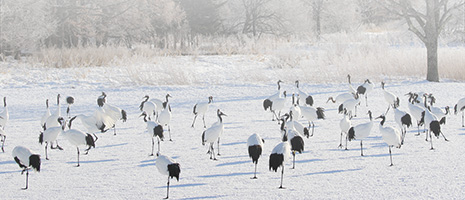Home > Highlighting JAPAN > Highlighting Japan January 2020 > Winter Pleasures
Highlighting JAPAN

Village of the Red-crowned Cranes
For many years, Tsurui Village in Hokkaido has conducted conservation activities to protect red-crowned cranes, with many flying in to the village to feed in winter months.
Measuring 1.4 meters in length and with a wingspan of 2.4 meters, the red-crowned crane is one of the largest wild birds in Japan. It has a patch of red on the crown, overall white plumage, a black neck, and black patches on its wings. While some, like the hooded crane and white-necked crane, migrate from continents such as Siberia and China to winter in Japan, places such as Kushiro Shitsugen marsh in eastern Hokkaido are home to red-crowned cranes year-round. From November to March, as food becomes scarce, the cranes gather at winter feeding sites established close to human habitation. Tsurui-Ito Tancho Sanctuary in Tsurui Village is one such site. In winter, some 300 red-crowned cranes fly in to feed at the sanctuary, established for their protection over approximately 12 hectares on the northern extremity of Kushiro Shitsugen. This is a rare opportunity to observe the cranes, which inhabit the interior of the marshlands outside the winter months.
While red-crowned cranes currently inhabit mainly eastern Hokkaido, until the Edo period (1603–1867) they bred all over the island, with some migrating to tidal flats and marshlands in the Tohoku and Kanto regions in winter.
“Red-crowned cranes were a very common sight on the outskirts of Edo (present-day Tokyo), as we can see from their depiction as part of the Edo landscape in the works of the famous late-Edo period ukiyo-e artist Utagawa Hiroshige. However, overhunting and the decline of wetlands and tidal flats due to development in the Meiji period (1868–1912) decimated their numbers until they disappeared altogether,” says Harada Osamu, a staff member at the Wild Bird Society of Japan and Chief Ranger at the Tsurui-Ito Tancho Sanctuary.
At one point, red-crowned cranes were believed to be extinct in Japan. Then in 1924 a dozen or so birds were discovered in Kushiro Shitsugen. After that, the red-crowned crane was designated as a national protected species and extensive conservation activities commenced.
“Various measures were taken, such as releasing loaches into the rivers of the marsh to provide food for the cranes. While the effects were minimal initially, red-crowned cranes were saved from extinction in large part due to the voluntary initiatives of local people. One such person was the late Ito Yoshitaka, the dairy farmer in Tsurui Village who bequeathed his name to the sanctuary,” says Harada.
In the winter of 1966, Ito began feeding livestock feed and dent corn to a pair of red-crowned cranes that landed on his pasture. Thereafter, in addition to dairy farming he continued to feed the birds, until gradually the number of red-crowned cranes that survived the harsh winters to breed in the spring increased. In 1987, the Wild Bird Society of Japan established the Tsurui-Ito Tancho Sanctuary on land leased from Ito. The Sanctuary became a base not only for feeding and observation, but also for activities to protect the habitat of red-crowned cranes in Hokkaido. Ito was committed to protecting red-crowned cranes until his death in 2000 at the age of 81.
A 1987 survey conducted by Hokkaido Government counted just 383 red-crowned cranes. Today, however, thanks to the success of initiatives such as the conservation of their marshland habitat and the winter feeding program, population numbers have been restored to approximately 1,800. This has led the Wild Bird Society of Japan to shift the focus of its conservation activities away from increasing the number of red-crowned cranes.
“The concentration of red-crowned cranes in feeding sites during the winter season makes them more vulnerable to infectious diseases. There have also been problems associated with the birds encroaching on areas inhabited by humans, such as accidents involving contact with power lines and motor vehicles, as well as damage to crops. The Ministry of Environment, which administers the red-crowned cranes conservation and proliferation project, is now limiting the amount of feed distributed to encourage the birds’ natural dispersion. We have established seventeen natural feeding grounds alongside water that does not freeze to lower the birds’ dependence on the feed. We also support the activities of local people protecting red-crowned cranes in new habitats. I don’t know how many decades it will take but we will continue with our conservation activities so that one day red-crowned cranes may once again become a common winter sight in Honshu,” says Harada.
© 2009 Cabinet Office, Government of Japan






